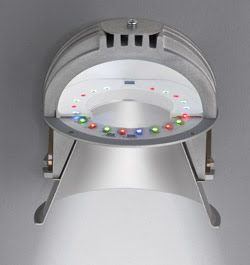LED lighting designers use geometry and sensors to smooth the output.
Rather than diverting laser-guided weapons, a technology developed under a US Air Force contract is now blending and controlling multiple LEDs in civilian applications.
The military effort originally focused on developing a countermeasure system that could throw off laser-guided weapons. Called “constructive occlusion,” the technology blends and controls the light of multiple LEDs to solve a few optical design dilemmas.
The problem with many LED fixtures is that you can see the individual LEDs inside, but even more critical is that the light output is choppy or pixelated. To overcome the pixelation, lighting designers use a lens or diffuser, which makes the light less efficient.

In a unique lighting design drawn from a military application, RGB or 4100 K white LEDs are arranged in a circular array at the perimeter of an integrating dome.
According to Jack C. Rains Jr., president and chief technology officer of Renaissance Lighting in Herndon, Va., constructive occlusion is a form of geometry that creates a single virtual light source from multiple sources. It works by diffuse surfaces tailoring how the light is distributed, eliminating the need for refractors or reflectors. By using constructive occlusion, an integrating cavity is formed with a reflective material. A mask is placed over the cavity so that the light source and most of the cavity are occluded. The cavity opening, the mask and the distance of the mask from the cavity combine to control the light distribution of the LEDs.
Output is a challenge
Besides constructive occlusion, the Renaissance Lighting design uses light sensors to measure the collective output from all the LEDs, and from that information, feedback circuitry corrects for deviations or wavelengths. Rains said that constructive occlusion could be used as the sensor, but the company chooses to employ ambient light sensors from Texas Advanced Optoelectronic Solutions of Plano, Texas, which help balance the light output. The output can be a challenge, as LEDs degrade over time, yielding mismatched colors, for example.
By combining the feedback from the light sensors with special algorithms, the color and light output are stabilized with no pixelation. Barry J. Weinbaum, chief executive officer at Renaissance Lighting, noted that the pixelation problem is “why you don’t see a lot of LED lighting out there.” The challenge is to “take advantage of energy savings and programmability and put it into a package that’s aesthetic.”
As for the age-old problem of heat dissipation, David Ramer, chief scientist and vice president of research and development, noted that, with this design, the company can place more space between LEDs to allow the heat to dissipate “and still have a single virtual source.”
With many countries having taken the oath to ban the sale of incandescent lightbulbs, alternatives such as LEDs and compact fluorescent lightbulbs (CFLs) are becoming the norm. CFLs, however, have mercury as an ingredient (albeit on a minuscule scale), making them less attractive to environmentally conscious consumers. That leaves the LED, which is becoming more available as both a screw-in lightbulb replacement and a lighting fixture, such as the Renaissance design.
The cost of LEDs has been prohibitive to the common consumer; however, according to Weinbaum, the prices of LED fixtures have dropped about 50 percent in the past year. Energy savings, longer life and reduced maintenance costs all add up to an increasingly attractive return on investment.